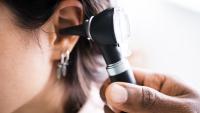Diagnostic Testing for Hearing and Balance
Make an Appointment
Our team is here to help you make an appointment with the specialists that you need.

At ColumbiaDoctors, our audiologists are skilled in the full range of diagnostics to assess hearing and balance disorders, including:
- Otoscopy: The audiologist will examine both ears with an otoscope (ear light) to determine if the ear canal is clear of any blockages (wax) and to visually inspect the tympanic membrane (eardrum). This is an important first step prior to further testing.
- Complete Audiometric Evaluation: Complete audiometric evaluations (hearing tests) are performed in a soundproof booth on both adults and children. Audiologist use ear insert ear phones (or headphones), through which you will hear both sounds and speech during the test. Your audiologist uses your responses to assess exactly how each ear is hearing. At the conclusion of testing your audiologist will discuss the results and appropriate next steps.
- Auditory Brainstem Response Testing (ABR): This evaluation measures the brain’s response to sound. For young infants (under six months of age), this testing can be completed in the office while the child sleeps. For older children, sedation is usually required to obtain accurate results. ABRs are particularly useful for confirmation of hearing loss or when behavioral audiological testing has been inconclusive. ABRs are also recommended for newborns who did not pass the initial hearing screening at birth. ABRs can may also be utilized for adults when information regarding the auditory system beyond the inner ear is desired. For ABR testing electrodes are placed on the head and ear phones are inserted into the ear canal. No response is needed from the patient for this test. The electrodes will measure how sound travels from the ear to the brainstem.
- Otoacoustic Emissions Testing (OAE): This test is frequently used as part of the newborn hearing screening program but is useful in patients of all ages. OAE testing measures the very soft sounds that are produced by hair cells in the inner ear, which vibrate in response to sound. If you have significant hearing loss, or a blockage in your outer or middle ear, no hair cell vibration will occur. To conduct an OAE test, audiologists place a small earphone, or probe, into your ear. The earphone will transmit sound into the inner are ear then measure the sound coming back. No response is needed from the patient for this test.
- Videonystagmography (VNG): VNG testing assesses balance organs in the inner ear and helps diagnose the cause of dizziness. This is a specialized test that uses infrared goggles to measure eye movements. Eye movements are analyzed to obtain information about inner ear balance function. The balance system is stimulated using visual tasks and by moving the body into different positions. The inner ear is also stimulated using both warm and cool air to asses if normal inner ear balance function is present.